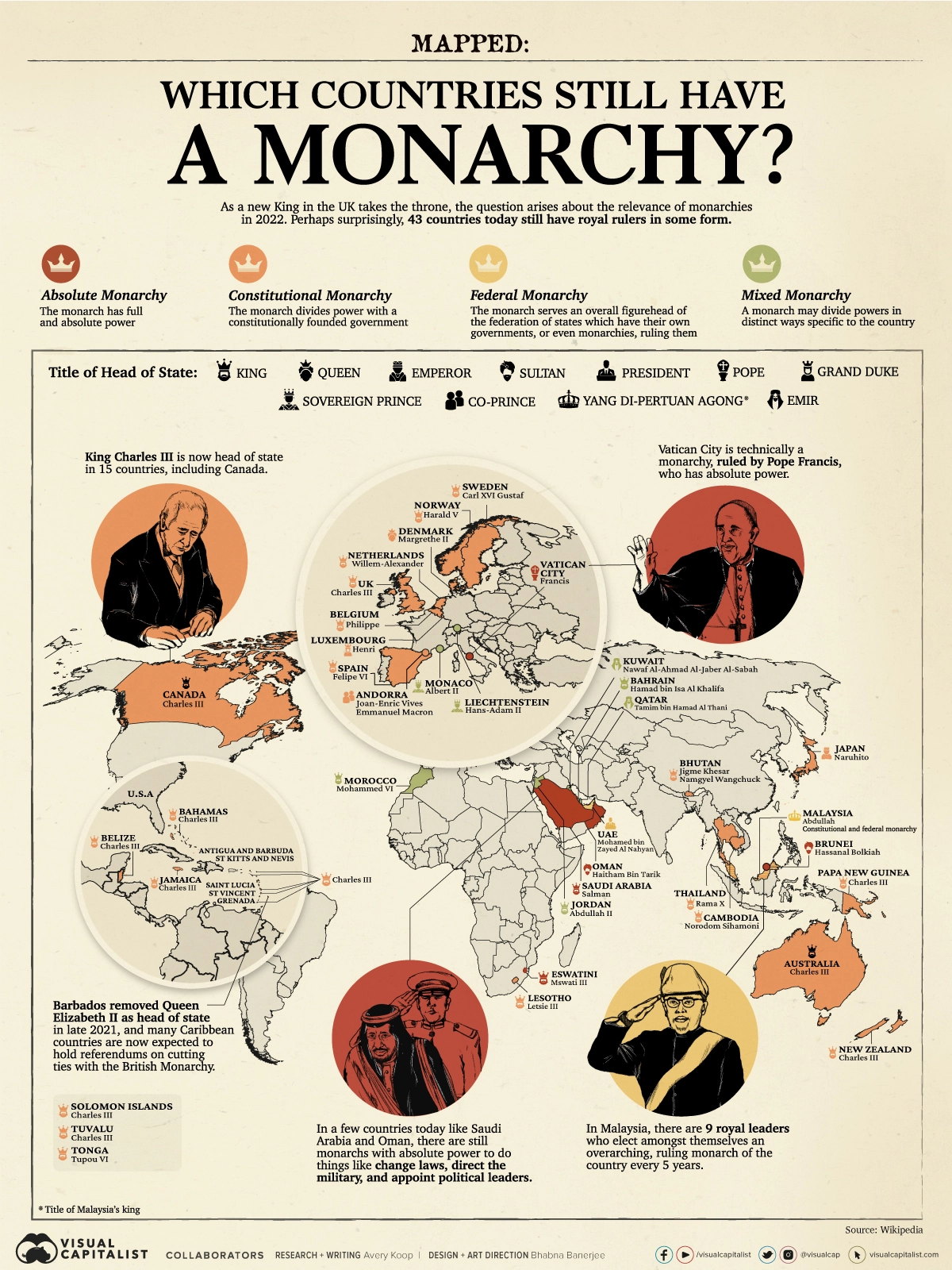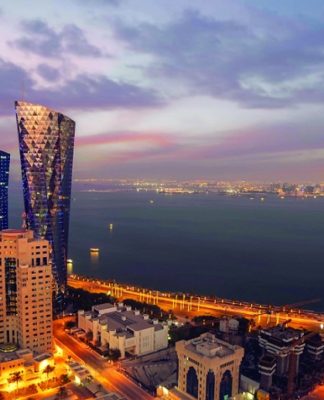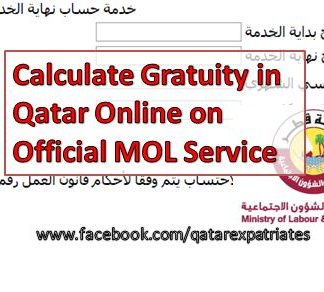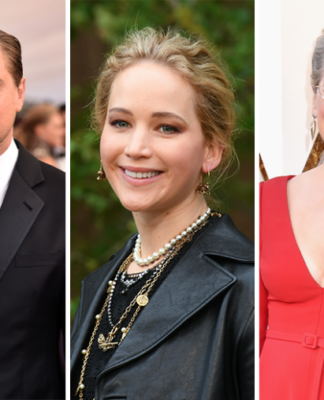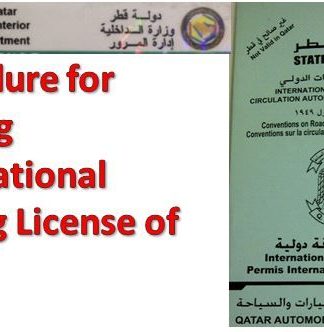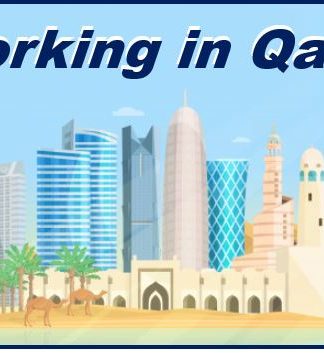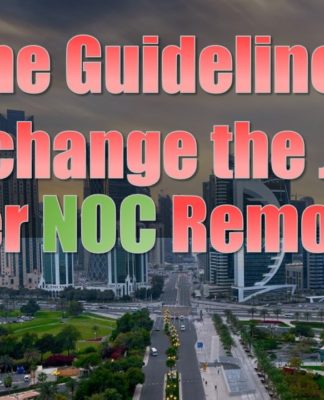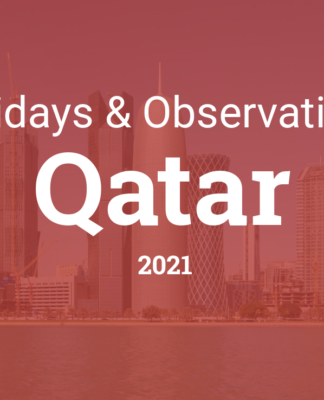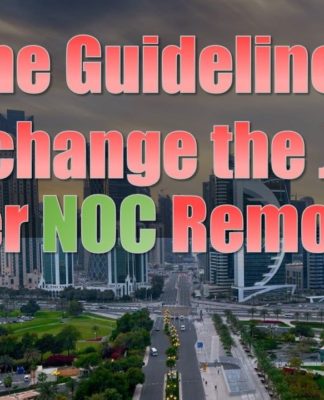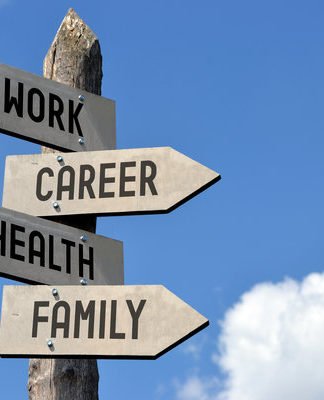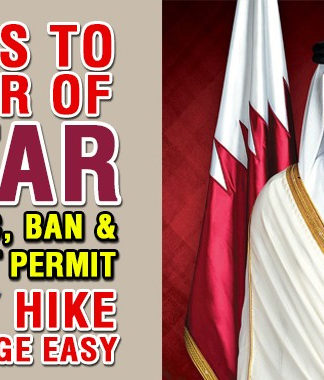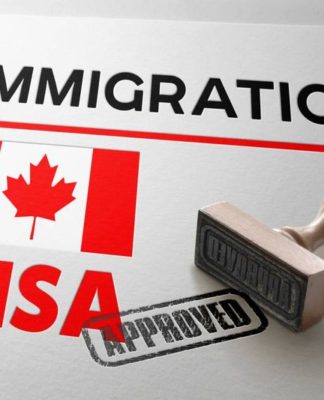Mapped: Which Countries Still Have a Monarchy?Published 2 days ago on September 16, 2022
By Avery Koop
Graphics/Design:
Bhabna Banerjee
Tweet
Share
Share
Reddit
Email
Map infographic showing the 43 countries that still have a monarchy
▼ Use This Visualization
Mapped: Which Countries Still Have a Monarchy?
In the wake of Queen Elizabeth II’s death, the question of monarchy is brought sharply into focus.
However, a surprising number of countries have ruling monarchs, and in this visual we break down the kinds of royal leadership across the 43 countries that still have them.
Types of Monarchies
A monarch in the simplest sense is a country’s king, queen, emir, or sultan, and so on. But before diving in, it’s important to break down the distinctions between the types of monarchies that exist today. Generally, there are four kinds:
① Constitutional Monarchy
The monarch divides power with a constitutionally founded government. In this situation, the monarch, while having ceremonial duties and certain responsibilities, does not have any political power. For example, the UK’s monarch must sign all laws to make them official, but has no power to change or reject new laws.
Here are some examples of countries with constitutional monarchies:
🇯🇵 Japan
🇬🇧 United Kingdom
🇩🇰 Denmark
② Absolute Monarchy
The monarch has full and absolute political power. They can amend, reject, or create laws, represent the country’s interests abroad, appoint political leaders, and so on.
Here are some examples of countries with absolute monarchies:
🇸🇿 Eswatini
🇸🇦 Saudi Arabia
🇻🇦 Vatican City
③ Federal Monarchy
The monarch serves an overall figurehead of the federation of states which have their own governments, or even monarchies, ruling them.
Here are some examples of countries with federal monarchies:
🇦🇪 UAE
🇲🇾 Malaysia
Malaysia is a unique form of federal monarchy. Every five years, each state’s royal leaders choose amongst themselves who will be the monarch, or the Yang di-Pertuan Agong, of Malaysia and the respective states. Furthermore, the monarchy is also constitutional, allowing a democratically elected body to govern.
④ Mixed Monarchy
This is a situation wherein an absolute monarch may divide powers in distinct ways specific to the country.
Here are some examples of countries with mixed monarchies:
🇯🇴 Jordan
🇱🇮 Liechtenstein
🇲🇦 Morocco
Interestingly, Liechtenstein is the only European monarchy that still practises strict agnatic primogeniture. Under agnatic primogeniture, the degree of kinship is determined by tracing descent from the nearest common ancestor through male ancestors.
Kings, Queens, Emperors, and Sultans Around the Globe
Now let’s break down the different monarchies country by country:
Country Type of Monarchy Title of Head of State Monarch Title of Head of Government
🇦🇩 Andorra Constitutional Co-Princes Joan-Enric Vives, Emmanuel Macron Prime Minister
🇦🇬 Antigua and Barbuda Constitutional King Charles III Prime Minister
🇦🇺 Australia Constitutional King Charles III Prime Minister
🇧🇭 Bahrain Mixed King Hamad bin Isa Al Khalifa Prime Minister
🇧🇪 Belgium Constitutional King Philippe Prime Minister
🇧🇿 Belize Constitutional King Charles III Prime Minister
🇧🇹 Bhutan Constitutional King Jigme Khesar Namgyel Wangchuck Prime Minister
🇧🇳 Brunei Darussalam Absolute Sultan Hassanal Bolkiah Sultan
🇰🇭 Cambodia Constitutional King Norodom Sihamoni Prime Minister
🇨🇦 Canada Constitutional King Charles III Prime Minister
PreviousNext
Constitutional monarchies are undoubtedly the most popular form of royal leadership in the modern era, making up close to 70% of all monarchies. This situation allows for democratically elected governments to rule the country, while the monarch performs ceremonial duties.
Most monarchs are hereditary, inheriting their position by luck of their birth, but interestingly, French president, Emmanuel Macron, technically serves as a Co-Prince of Andorra.
Another unique case is the Vatican’s Pope Francis, who has absolute power in the small independent city—he gained his role thanks to an election process known as a papal conclave.
The Role of Monarchies
One of the most notable and famous ruling monarchies is the United Kingdom’s House of Mountbatten—also known as Queen Elizabeth II’s family. King Charles III has now ascended to the country’s throne, making him head of state in 15 nations total, including Canada, Australia, and New Zealand.
Many see the benefit in having a stable and consistent form of tradition and decorum at the country’s head of state.
“The Crown is an integral part of the institution of Parliament. The Queen [now King] plays a constitutional role in opening and dissolving Parliament and approving Bills before they become law.” – BRITISH PARLIAMENT
Japan’s royal family has been a prime example of stability, having reigned in the country for more than 2,600 years under the same hereditary line.
Critiques and the Future of Monarchy
Some claim, however, that there is no function of monarchy in the modern day, and complaints of monarchies’ immense wealth and power are rampant.
For example, according to the Dutch government, King Willem-Alexander’s budget for 2022, funded by the state and thus, taxpayers, comes out to more than €48 million.
Beyond tax dollars, with absolute monarchies there is typically a lack of political freedoms and certain rights. Saudi Arabia, for example, has no national elections. Rather its king, Salman bin Abdulaziz Al Saud, stays in power for life, appoints the cabinet himself, and passes laws by royal decree.
The death of Queen Elizabeth, though, may bring about change though for many of the world’s royally-governed. Since Barbados’ removal of her as head of state in 2021, six other Caribbean nations have expressed the desire to do the same, namely:
🇧🇿 Belize
🇧🇸 The Bahamas
🇯🇲 Jamaica
🇬🇩 Grenada
🇦🇬 Antigua and Barbuda
🇰🇳 St. Kitts and Nevis
The future of monarchy in the 21st century is certainly not a guarantee.














